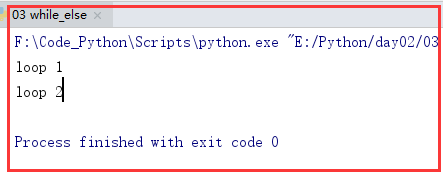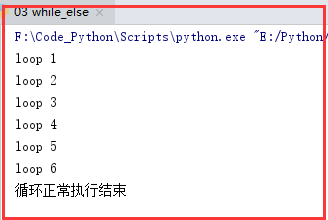1. while
终止while循环:
(1) 改变条件,使其不成立
(2) break
应用实例1:计算1+2+3+...+100
#1.使用两个变量 count = 1 sum = 0 while count <= 100: sum = sum + count count = count + 1 print(sum) #5050 #2.使用三个变量 count = 1 sum = 0 flag = True while flag: sum = sum + count count = count + 1 if count > 100: flag = False print(sum)
应用实例2:打印1-100
#1.使用两个变量 count = 1 flag = True while flag: print(count) count = count + 1 if count > 100: flag = False #2.使用一个变量 count = 0 while count <= 100: print(count) count = count + 1
2. continue
结束本次循环,继续下一次循环
#一直循环输出1
count = 1 while count < 20: print(count) continue count = count + 1
3. break
print('11') while True: print('222') print(333) break print(444) print('abc')
应用实例:打印1-100
count = 1 while True: print(count) count = count + 1 if count > 100:break
4. while-else
(1)while循环被break打断,则不执行else
(2)while循环未被break打断,则执行else
count = 0 while count <= 5: count += 1 if count == 3: break #(1)不执行else,如下左图 #pass #(2)执行else,如下右图 print('loop',count) else: print('循环正常执行结束')


5. 逻辑运算符or_and_not

(1)x or y
若x为真,返回x(0为假,其余为真);否则返回y
print(1 or 2) #1 print(1 or 5) #1 print(0 or 1) #1 print(0 or 2) #2
(2)x and y(结果与or相反)
若x为真,返回y(0为假,其余为真);否则返回x
print(1 and 2) #2 print(1 and 5) #5 print(0 and 1) #0 print(0 and 2) #0
(3)not x
若x为真,返回True;否则返回False
print(not 0) #True print(not 1) #False print(not 56) #False